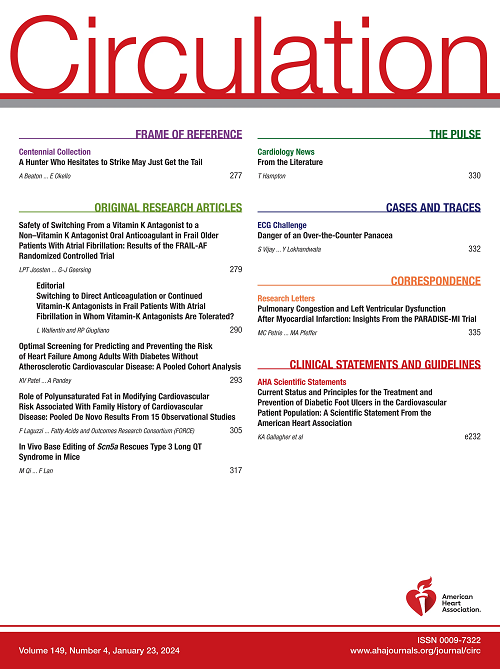通过TRPV4-RhoA-RhoGDI1轴使RhoA失活治疗高血压
IF 35.5
1区 医学
Q1 CARDIAC & CARDIOVASCULAR SYSTEMS
引用次数: 0
摘要
RhoA (Ras同源家族成员A)信号通路在调节血管平滑肌细胞(VSMCs)功能和血压稳态中起关键作用。目前的RhoA信号通路抑制剂在高血压治疗中受到限制,存在疗效差、特异性不足和发育方面的挑战。方法采用电镜观察(sem)、近距离结扎实验(PLA)和定点诱变等方法,探讨RhoA活性调控的机制。采用VSMC、高血压动物模型、Trpv4-/-和arhdiaf /f Myh11-CREERT2(平滑肌特异性RhoGDI1敲除)小鼠,研究Trpv4(瞬时受体电位阳离子通道亚家族V成员4)- rhoa -RhoGDI1 (Rho GDP解离抑制剂1)轴在高血压中的作用。结果发现sah001 ((R)-1-(3-乙基苯基)乙烷-1,2-二醇)是RhoA信号通路的新型抑制剂。它以TRPV4-RhoA-RhoGDI1轴为靶点,有效地将失活的RhoA- gdp隔离在质膜和细胞质中,不同于典型的RhoA抑制模式。TRPV4AH001-RhoA复合物的低温电镜结构表明,与ah001结合的TRPV4与RhoA呈封闭状态,RhoA处于非活性的gdp结合状态。功能研究进一步发现,AH001通过增强VSMC中TRPV4-RhoA的结合和促进RhoGDI1-RhoA的相互作用,减少了活性RhoA的数量。这种抑制作用显著降低了angii诱导的高血压小鼠和自发性高血压大鼠的急性和长期血压,并阻止了血管重塑。然而,这些抗高血压作用在Trpv4-/-和arghdiaf / fmyh11 - creert2小鼠中减弱。此外,AH001通过RhoA/ROCK (rho相关蛋白激酶)/MYPT1(肌球蛋白磷酸酶靶亚基1)/MLC(肌球蛋白轻链2)信号通路有效抑制VSMC收缩,并通过RhoA/ROCK/LIMK1 (LIM结构域激酶)/cofilin/MRTF-A(心肌素相关转录因子A)/SRF(血清反应因子)信号级联抑制VSMC表型向肌成纤维细胞的转换。TRPV4和RhoGDI1的敲除减弱了AH001对VSMC收缩的抑制和向肌成纤维细胞的表型转换。结论本研究揭示了一种靶向TRPV4-RhoA-RhoGDI1轴的RhoA信号抑制新模式,为未来抗高血压药物的开发提供了新的见解,并提出了靶向挑战性Rho GTPases的创新策略。本文章由计算机程序翻译,如有差异,请以英文原文为准。
Inactivation of RhoA for Hypertension Treatment Through the TRPV4-RhoA-RhoGDI1 Axis.
BACKGROUND
The RhoA (Ras homolog family member A) signaling pathway is pivotal in regulating vascular smooth muscle cells (VSMCs) function and blood pressure homeostasis. Current inhibitors of the RhoA signaling pathway are limited in hypertension treatment, suffering from poor efficacy, insufficient specificity, and developmental challenges.
METHODS
Cryo-electron microscopy (EM), proximity ligation assay (PLA), and site-directed mutagenesis were used to explore the mechanism of RhoA activity regulation. VSMC, hypertensive animal models, Trpv4-/- and Arhgdiaf/f Myh11-CREERT2 (smooth muscle-specific RhoGDI1 knockout) mice were used to investigate the role of the TRPV4 (transient receptor potential cation channel subfamily V member 4)-RhoA-RhoGDI1 (Rho GDP dissociation inhibitor 1) axis in hypertension.
RESULTS
AH001 ((R)-1-(3-ethylphenyl) ethane-1,2-diol) was identified as a novel inhibitor of the RhoA signaling pathway. It targets the TRPV4-RhoA-RhoGDI1 axis to effectively sequester inactive RhoA-GDP in the plasma membrane and cytoplasm, which is distinct from typical RhoA inhibition modes. The cryo-EM structure of the TRPV4AH001-RhoA complex showed that AH001-bound TRPV4 adopts a closed state with RhoA in an inactive GDP-bound state. Functional studies further revealed that AH001 reduced the pool of active RhoA by enhancing TRPV4-RhoA binding and facilitating RhoGDI1-RhoA interaction in VSMC. This inhibition notably decreased both acute and long-term blood pressure and prevented vascular remodeling in Ang II-induced hypertensive mice and spontaneously hypertensive rats. However, these antihypertensive effects were weakened in Trpv4-/- and Arhgdiaf/f Myh11-CREERT2 mice. Additionally, AH001 effectively inhibited VSMC contraction via the RhoA/ROCK (Rho-associated protein kinase)/MYPT1 (myosin phosphatase target subunit 1)/MLC (myosin light chain 2) signaling pathway and suppressed VSMC phenotype switching to myofibroblasts through the RhoA/ROCK/LIMK1 (LIM domain kinase)/cofilin/MRTF-A (myocardin-related transcription factor A)/SRF (serum response factor) signaling cascade. TRPV4 and RhoGDI1 knockdown attenuated AH001's inhibition of VSMC contraction and phenotypic switching to myofibroblasts.
CONCLUSIONS
This study revealed a novel mode of RhoA signaling inhibition targeting the TRPV4-RhoA-RhoGDI1 axis, offering new insights for future antihypertensive drug development and proposing innovative strategies for targeting challenging Rho GTPases.
求助全文
通过发布文献求助,成功后即可免费获取论文全文。
去求助
来源期刊

Circulation
医学-外周血管病
CiteScore
45.70
自引率
2.10%
发文量
1473
审稿时长
2 months
期刊介绍:
Circulation is a platform that publishes a diverse range of content related to cardiovascular health and disease. This includes original research manuscripts, review articles, and other contributions spanning observational studies, clinical trials, epidemiology, health services, outcomes studies, and advancements in basic and translational research. The journal serves as a vital resource for professionals and researchers in the field of cardiovascular health, providing a comprehensive platform for disseminating knowledge and fostering advancements in the understanding and management of cardiovascular issues.
 求助内容:
求助内容: 应助结果提醒方式:
应助结果提醒方式:


